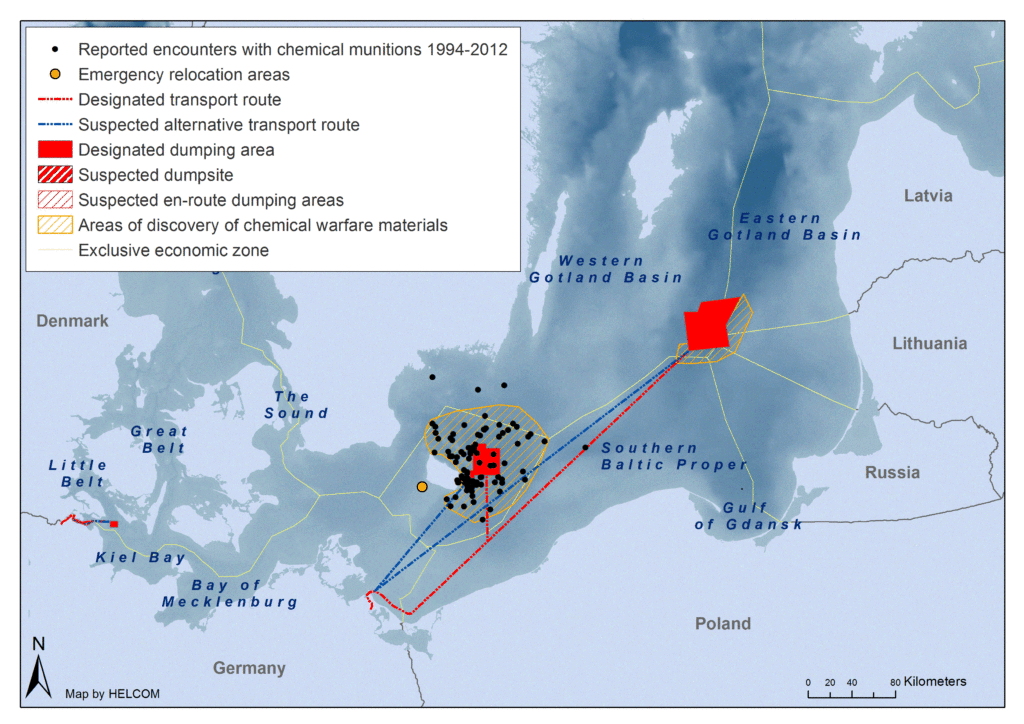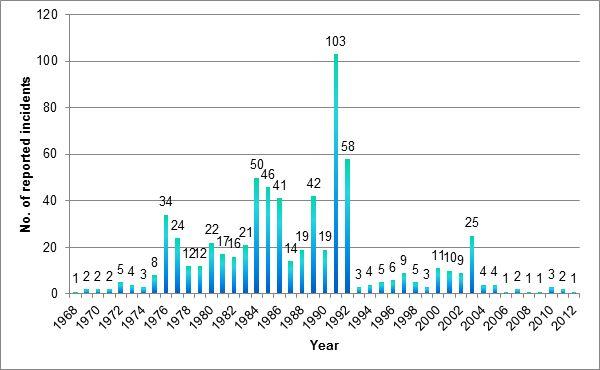Sea-Dumped Chemical Munitions
Dumping History
About 40,000 tonnes of chemical munitions were dumped into the Baltic Sea after the Second World War. It is estimated that these chemical munitions contained some 15,000 tonnes of chemical warfare agents (this figure does not take into account the dilution and degradation which have taken place).
They have been mainly dumped mainly item-by-item from ships headed for the designated dumping areas. Materials were thrown overboard in the region of target areas as well as en route from the loading harbours (e.g., Wolgast and Flensburg). It is clear that chemical warfare materials were scattered within the dumping areas marked on sea charts, in their vicinity and on the former transport routes. There still remains uncertainty about the total amounts, types and exact locations of dumped chemical warfare materials.
Dumping Sites
In general, the main idea was to dump chemical munitions as far away and as deep as possible. However, this was not always achievable due to the lack of available resources (e.g., obsolete but reasonably sea-worthy ships for scuttling) and tight schedules for demilitarization.
During the last stages of WWII, the southern entrance to the Little Belt was used by German troops as a reachable dumping area in the Baltic Sea. With a depth of about 30 m, it is the shallowest of all dumping sites. In the post-war period, the Military Administrations in Germany chose deeper basins exceeding water depths of 70 m south-east of Gotland, east of Bornholm and in the Skagerrak for dumping chemical warfare materials.
During transport to the dumping areas east of Bornholm and south-east of Gotland munitions have been thrown overboard while ships were en route. As some munitions were dumped in wooden cases some have drifted outside the area where they were dumped.

Overview map of known and suspected dumpsites of chemical warfare materials in the Helsinki Convention Area. Reported encounters with chemical warfare materials and emergency relocation areas are also indicated. Click image to enlarge. The data used in the map can be downloaded from the HELCOM Data and Map Data Service.
Risk of Encounters
Even today, the possibility of people encountering chemical warfare materials while working in the marine environment of the southern and western Baltic Sea cannot be ruled out (e.g., fishermen and workers involved in offshore construction activities). In view of the increasing utilization of the seafloor for economic purposes (e.g., offshore wind farms, sea cables, pipelines), the risk of encountering sea-dumped munitions is increasing.
In addition, in certain areas of concern in the southern Baltic Sea (Germany, Poland and Latvia), beach visitors are at risk of coming into contact with white phosphorus washed ashore. This incendiary agent can cause severe burns and is highly toxic.
According to the historical information available, sulfur mustard is the most abundant chemical warfare agent in the dumped munitions. This chemical agent poses a present risk to humans who come into contact with it, and to organisms within its immediate vicinity, taking into account both short- and long-term effects.
Number of Incidents Reported Where Chemical Munitions Have Been Caught by Fishermen
HELCOM maintains an annual record on the reported incidents related to chemical munitions caught by fishermen. there is a clear decrease in the annual number of reported incidents, with the exception of 2003. Possible reasons for this decrease are changes in the local abundance of fish, fewer fishing hours, the use of state-of-the-art fishing gear and gaps in national reports. As there are uncertainties associated with the reporting of incidents, the figures do not necessarily reflect the actual situation. The change in the early 1990s coincides with the decline of the fishing activities in areas off Bornholm.

Number of reported incidents of trawled up chemical warfare materials in the years 1968-2012
Effects on the Marine Environment
According to existing knowledge, chemicals originating from chemical warfare materials can spread from the disposal sites of the containers due to natural and anthropogenic processes. Sediments at, and in the vicinity of, the dumping grounds have been shown to be in various stages of contamination with chemicals presumably originating from chemical warfare materials.
Arsenic-containing warfare agents have been shown to contaminate areas of the sea bottom and to spread both within and outside the dumpsites. In all cases investigated so far, however, no chemical warfare agent parent compounds or degradation products were detected in the water column in measurable quantities.
The environmental impact of chemical warfare agent mixtures has not been thoroughly assessed by ecotoxicological means – only theoretical considerations and modelling have been used to fill this experimental gap.
Little is known about the magnitude of the effect of different chemical warfare agents and the degradation products towards marine organisms. And although no direct observations have been made to date, contemporary scientific studies in other marine regions have indicated that adverse effects are possible for marine biota.
